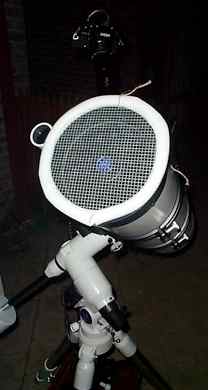 |
|||||
The best way to construct the focuser is to cut a circle of flat chicken wire and strap it with string onto a rigid ring (something like the old turntable ring from a microwave that I used). Use a couple of bits of string to hold it in place on the ring, then draw the mesh flat applying slight tension with more loops of string threaded through the wire grid at the ring. The ring should be sized so it fits safely and snuggly over the front of the telescope tube without the wire being anywhere near the glass at the front. For added safety use some sort of padding, like the cheap concertina electrical hose that I used around the edge of mine. A long flexible strip of foam or plastic would also do. Adjust focus until the diffraction spikes are brightest. You will quickly learn to recognise the differences in the diffraction pattern to tell when you are in focus. This is when the spikes are thinnest, and brightest, and when the dark gaps that are spaced along the spikes are well defined, widest and darkest. The resulting focus won't be exact. Like the Hartmann Mask you still have to make a subjective decision on brightness and sharpness - of the diffraction pattern. When you are near focus you will be able to move the telescope's focus wheel slightly without knowing whether this has improved or worsened the focus. In my opinion focus with the wire mesh focuser appears more precise on average than with a Hartman Mask when the seeing (air turbulence) is bad or average. I've demonstrated this on video by recording the dots from a Hartman Mask dancing about, going in and out of focus as the mask's two light rays took slightly different paths through the turbulent atmosphere. A moment later when I held up the chicken wire it was obvious from the sharp diffraction pattern, that I was still in focus. It does seem that the diffraction pattern is not as susceptible to atmospheric turbulence. Also check out my other equipment reviews: The Bahtinov Mask which is a sensational new variation of the Hartmann Mask. Excellent !!! A home-made Hartmann Mask which is another primitive device for judging focus. The Telrad which all newbies absolutely must have. A Barn Door Tracker for taking long exposure wide-field photos of the sky.
All images and content of this website are copyright (c)2005 Bill Christie. All rights reserved. |

